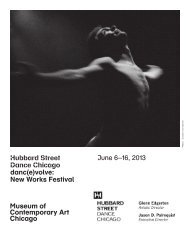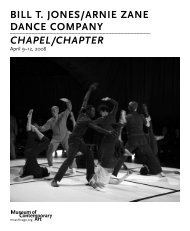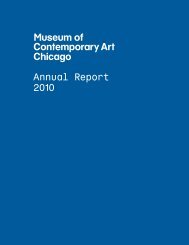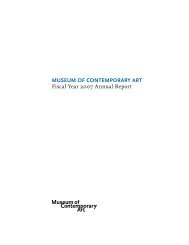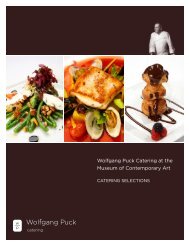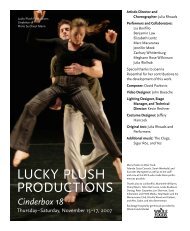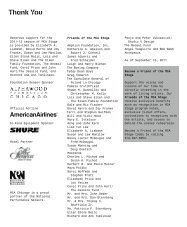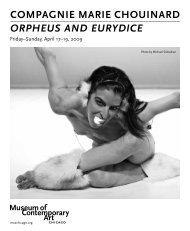Program Notes - Museum of Contemporary Art, Chicago
Program Notes - Museum of Contemporary Art, Chicago
Program Notes - Museum of Contemporary Art, Chicago
You also want an ePaper? Increase the reach of your titles
YUMPU automatically turns print PDFs into web optimized ePapers that Google loves.
About the program<br />
George E. Lewis: <strong>Art</strong>ificial Life 2007 (2007)<br />
Created for the Glasgow Improvisers Orchestra,<br />
<strong>Art</strong>ificial Life 2007 is a schema for collective improvisation—and<br />
collective silence. No musical<br />
material is prescribed; the principle is stimulus,<br />
and the medium is verbal instructions that give<br />
rise to radically different results, depending on<br />
the performers taking part.<br />
There are just two pages to these instructions,<br />
which may be followed separately, in either<br />
order, or together. Page 1 is to be read by musicians<br />
acting individually or in groups, and is the<br />
same for everyone: a set <strong>of</strong> sixteen words, some<br />
<strong>of</strong> them suggesting kinds <strong>of</strong> sound (“smooth,”<br />
“soli”), some having to do with how one soloist<br />
or group might respond to one another (“end,”<br />
for example, asks for an imitative response to<br />
another group, starting immediately as that other<br />
group has come to an end). Page 2 consists <strong>of</strong><br />
single words or very elementary directions and<br />
proposes several groups (at least three) each<br />
create a pathway either in relation to what is happening<br />
or independently.<br />
Lewis further suggests that moments <strong>of</strong> silence<br />
will be needed—not empty silence, but a silence<br />
filled with listening and decision-making as the<br />
musicians prepare to contribute to the artificial<br />
life that is their joint creation. “The success <strong>of</strong> the<br />
performance,” the composer finally notes, “is not<br />
so much related to individual freedoms but to the<br />
assumption <strong>of</strong> personal and collective responsibility<br />
for the sonic environment.”<br />
© Paul Griffiths, http://disgwylfa.com<br />
Steve Lehman: Impossible Flow<br />
(2010, rev. 2012)<br />
“In Impossible Flow, delicate and highly nuanced<br />
spectral harmonies are integrated into a series <strong>of</strong><br />
meticulously crafted rhythmic environments. Expressive<br />
timing, compound meter, rubato phrasing,<br />
changing tempi, irrational rhythms, and instrumental<br />
gesture are treated as a seamless continuum<br />
designed to explore the psychology <strong>of</strong> musical<br />
time and its connection to the elision <strong>of</strong> timbre and<br />
harmony in spectral music. By imagining Impossible<br />
Flow in this way, I hope to create an elaborate<br />
sense <strong>of</strong> directionality and form that remains rooted<br />
in the physicality <strong>of</strong> live performance and the<br />
corporeal nature <strong>of</strong> urban rhythmic sensibilities.”<br />
—Steve Lehman<br />
Nicole M. Mitchell: Cave <strong>of</strong><br />
Self-Induction (2012)<br />
“Before thought, before the birth <strong>of</strong> an idea, one<br />
enters a dark cave <strong>of</strong> formlessness, <strong>of</strong> timeless<br />
and endless potential. The cave is where all<br />
minds meet, where all minds have met, in search<br />
<strong>of</strong> Source, before sound, before self, before<br />
manifestation’s beginning.”<br />
—Nicole M. Mitchell<br />
Tyshawn Sorey: Ode to Gust Burns<br />
(2012; ICElab commission)<br />
“Eight years ago, on a cold, rainy day in New York<br />
City, the pianist Vijay Iyer and I decided to listen<br />
to some music together at his apartment; we<br />
listened to a CD containing four solo improvisations<br />
by Seattle-based pianist/composer Gust<br />
Burns, whose music was astonishingly beautiful.<br />
Burns creates a unique dialogue between gesture<br />
and rhythm in his improvisations. His approach<br />
to piano performance opens up a world<br />
<strong>of</strong> sound complexes, creating a fresh, relevant<br />
language <strong>of</strong> improvisation. Burns’s work continues<br />
to inspire me as an improviser and composer,<br />
and Ode to Gust Burns directly deals with<br />
my initial exposure to his music.”<br />
—Tyshawn Sorey



